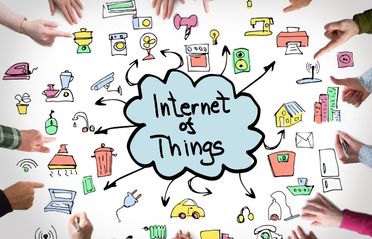We are currently at the forefront of developing new and amazing systems by leveraging what Blockchain has to offer. The decentralized nature of Blockchain means higher levels of security. While it initially seemed like an excellent opportunity to improve financial institutions, Blockchain is showing growing potential in the healthcare sector, government, and now, the Internet of Things.
The Internet of Things itself is like accomplishing a futuristic lifestyle from an early 2000’s sci-fi movie. IoT can help interconnect every appliance in your house thereby enabling your home to talk to you. While full connectivity is still a dream, tech giants are flexing to make it a possibility. No matter how convenient it can become, the Internet of Things is highly susceptible to cyber-attacks. The mere nature of such a system means that it holds a plethora of valuable information concerning individuals and their personal lives.
Why Does The IoT Need More Security?
You would think that such an intricate and advanced system would come with inbuilt security but the botnet-based DDoS attacks of 2016 show otherwise. Two years down the line, we have made significant advancements, but there is still a long way to go before organizations can feel secure while implementing an IoT connection.
The reason for this is that the current model still relies on a centralized system that manages connections between devices. As centralized systems are outdated and under a constant threat of cyber-attacks, this proves that blockchain can provide the solution they need.
The Problem Behind Centralized Servers
Implementing a centralized server to have universal access could have devastating effects on people and corporations everywhere. Here is how it can get dangerous.
Compromised Online Security
An IoT-configured home or space means that a hacker can enter the connection and access crucial data through any appliance or device. This means that if your fridge or coffee maker is connected to the same system as your computer, hackers will not have trouble navigating through all devices once they enter the configuration. Private details like passwords and contacts – all the ingredients for a recipe of identity theft – will be in the hands of dangerous people.
Invaded Security Systems
Plenty of homeowners and corporations have surveillance systems that help them keep security in check. Even today they are mostly connected to a centralized server, which is easy for hackers to access. Not only does it result in an invasion of privacy, but bigger corporations are under the threat of a burglary.
Complete Malfunction and System Shutdown
While some hackers want to steal precious data or are obsessed with learning about someone’s personal life, others just want the pleasure of shutting things down. They can break through whatever security the IoT offers in a variety of ways. And for this, all they need is the time and skill.
After they’ve entered the system, like knocking down a line of dominos, they can shut down one appliance after the other. Hackers can infect your appliances with a malicious code, shut them down and even make the network useless. It does not matter if you spent years trying to configure an interconnected network; a person with all the right skills can shut it down within a couple of hours.
IoT needs a Savior!
In a rush to advance and introduce the IoT network to consumers, no one seemed to notice that the security measures could be bypassed easily. Needless to say, every person with an IoT system was basically prone to possibly the biggest privacy and security threat of the century. The Mirai Botnet incident is a perfect representation of malware attacking the IoT.
What can Blockchain provide?
Before Blockchain had its moment, people considered Bitcoin to be the shining star of cryptocurrency and decentralized technology. During that time, there were people who were interested in the solution to fiat currency but there were also others who were more focused on the technology that made up the database.
The blockchain technology was a promise to make online environments more secure than ever because it blows previously held concepts of centralized authority out of the water. It decentralizes the network, whether it is for a financial institution or the IoT network that powers your household appliances.
Therefore, all people participating in the Blockchain will have to verify and authorize a transaction before it can be considered legitimate. Although applying Blockchain will not make the network immune to hacks, it will be somewhat close. Since hackers will need vast amounts of computing power and technology resources before being able to overcome a Blockchain; smaller organizations or solo hackers will not be able to amass such resources.
How does it save the system?
In the current centralized IoT network, the devices are what we would like to call ‘smart’. However, they are not capable of making security-based decisions that fall outside the grasp of central authority. In a model that synchronizes Blockchain and the IoT, each device’s set of data is replicated and stored on the decentralized server.
This can be further understood by an example that involves DNS Hijacking. DNS or Domain Name Server is responsible for mapping user friendly domains to their corresponding IP addresses. The DNS server is owned and maintained by the Internet Service Provider and several private business organizations. In the normal scenario and for reasons of their own, a hacker can take control of a computer to change the DNS setting and lead unsuspecting users via their own rogue DNS to fake and malicious sites. However, the events may not unfold in the same fashion if the DNS server is placed on a Blockchain. Whenever a hacker needs to gather sources for an attack on the DNS (that is now placed on Blockchain), they will need to add data to the Blockchain and before this can happen – it needs to be approved and verified by all the participants in the network, thereby rendering the exercise rather impossible.
A practical application of Blockchain in IoT can be visualized in a Smart Home scenario. Millennials, especially are the drivers in the unprecedented growth of IoT in recent years. They want to control everything, from switching on/off the electrical appliances to locking their doors by just using their smartphones. Smart homes have a lot of IoT enabled smart devices that are connected to each other over a common network. A hacker can easier hack one of the devices, change its settings and their render the entire network useless. However, if these devices are put on a Blockchain network, then due to the inherent immutability of Blockchain technology, these devices become unchangeable and therefore safe from cyber-attacks. Essentially the hacker cannot access the home or data collected by the IoT devices involved in the Smart Home set-up. For example, American global telecommunications conglomerate Comcast, uses Blockchain technology to create a permission-based ledger. This ledger enables the homeowner to grant access permissions remotely through a mobile application. The mobile app also enables them to revoke these permissions at the click of a button.
Challenges en route
Despite being the solution to the risks of a major security breach, some complications can get in the way of incorporating Blockchain in the IoT network. The reason being, the network itself is not as developed as it needs to be and neither is the current Blockchain technology that we have.
As of today, Blockchain is the most advanced to move cryptocurrency from one wallet to another, but securing layers in a network of millions of devices would require a far more complex and developed infrastructure. The framework needs to be capable of preventing intrusions and removing devices that have been hacked as a means of containing the threat and stopping the malware from spreading.
Another issue that needs attention is the agreement that is required from millions of IoT devices before the Blockchain can be controlled. This can be immensely difficult to achieve, considering that the network is scattered throughout the world. Let’s not forget that the devices that we currently have on the IoT, such as appliances, phones, and household assistants, aren’t equipped with the necessary computing strength to power a decentralized network.
Currently, the implementation of Blockchain in IoT faces numerous challenges with the network still prone to attacks. Nonetheless, there are high chances for improvement and further development as Blockchain technology becomes easier and cheaper to implement, it will greatly reduce the levels of panic among people who want to keep their devices safe from threats of shutting down.
References:

Product Engineering Services Customized software development services for diverse domains
Quality Assurance End-to-end quality assurance and testing services
Managed Services Achieve scalability, operational efficiency and business continuity
Technology Consulting & Architecture Leverage the extensive knowledge of our Domain Experts



